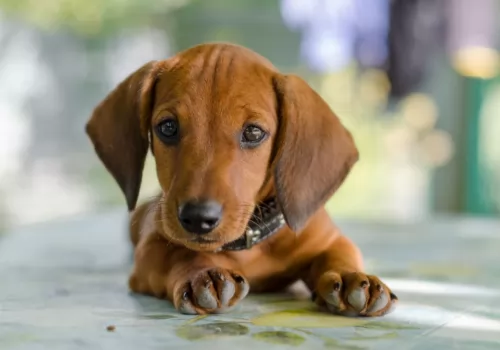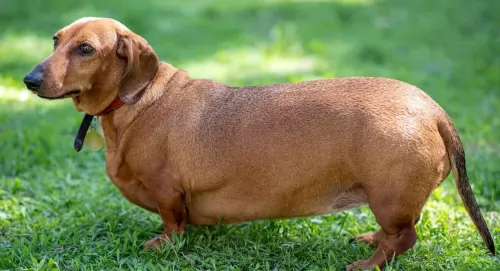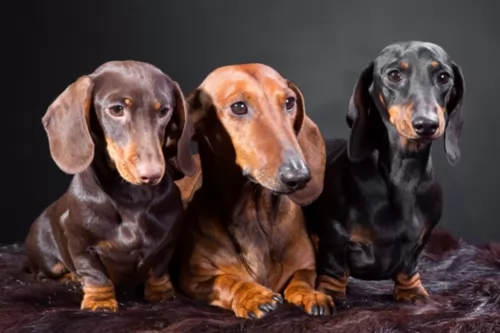 MyDogBreeds
MyDogBreedsNorth Country Beagle is originated from United Kingdom but Dachshund is originated from Germany. North Country Beagle may grow 17 cm / 7 inches higher than Dachshund. Both North Country Beagle and Dachshund are having almost same weight. Both North Country Beagle and Dachshund has almost same life span. Both North Country Beagle and Dachshund has almost same litter size. Both North Country Beagle and Dachshund requires Low maintenance.
Known also as the Northern Hound or the Northern Beagle, the North Country Beagle hailed from Britain and is extinct.
It hailed more specifically from- and was native to the Yorkshire and Northumberland regions of England. As a scenthound it was known for its hunting skills.
There isn’t much known about the dog but it is one of England’s oldest hound breeds, with much of its ancestry been lost. There are many theories surrounding the origins of this dog. Also, the date at which the North Country Beagle was developed is also debatable but it has always been a good hunter.
 The Dachshund originated in Germany. He was used as a hunting dog with his origins starting way back in the 15th century already. The small dog was developed to hunt for animals that buried themselves deep underground such as badgers. The shape of the dog and his courage and bravery allowed him to take on the badger.
The Dachshund originated in Germany. He was used as a hunting dog with his origins starting way back in the 15th century already. The small dog was developed to hunt for animals that buried themselves deep underground such as badgers. The shape of the dog and his courage and bravery allowed him to take on the badger.
There has been a lot of debate as to whether the Dachshund is a hound or terrier, and it was decided that the Dachshund is a hound that became a terrier, and which displays some of the best qualities of both.
It was in 1881 that the Dachshund Club of England was formed and the German Deutscher Teckelklub was formed in 1888. The small dog gained popularity in America and the Dachshund Club of America was founded in 1895.
The North Country Beagle seemed to vary quite a bit in size and because there isn’t much information on this extinct dog, we can assume he was much the same size of the Beagle we know today which is roughly 33 – 45cm in height and weighing between 9 and 11kg.
Not much is known about the dog’s appearance but it is believed that it looked much like the Southern Hound and English Foxhound. It was likely a medium sized dog with longish ears, thick bones but always agile and athletic.
There is very little known on what this dog’s temperament was like. He was strong willed and if you owned such a dog you would have had to have him trained and socialized. It was a dog that showed very little signs of aggression. It seemed the dog was friendly, social and loving to his human family.
 Known as Badger Dogs, Sausage Dogs or Doxies, the Dachshund is known for his long body, his sharp, pointed face and the short legs with the large front paws.
Known as Badger Dogs, Sausage Dogs or Doxies, the Dachshund is known for his long body, his sharp, pointed face and the short legs with the large front paws.
He stands at about 21-28 cm while the female may be 20-25 cm and weighing 6 to 15kg. He is the smallest of the hound dogs, with the standard size dachshund being developed to scent and chase badgers and other animals.
There are different Dachshund coat varieties – the smooth coat, the long-haired Dachshund and the wire-haired dachshund. They also come in a number of solid colors such as brown, red, tan, chocolate and black.
The dachshund is an energetic,social little dog with a loving personality. He’ll love to lie as close as possible to you on the couch and be with you wherever you are. Training and socialization is important so he doesn’t become too protective so that he wants to go for anyone who comes near.
He can be stubborn but he is also protective of his human family. Dachshunds are known for their tendency to bark but training and socialization can help tremendously to make him obedient and relaxed around humans and pets.
He is small enough to be a great pet in the city or in the country. He loves to spend time indoors- as well as outdoors. He can become a loving companion and gets on well with children and pets in the house. In spite of his small size, he makes a good watchdog.
The North Country Beagle was a social, energetic dog who loved spending time with his human family. They were intelligent too, so training and socialization were possibly easy for him.
They weren't regarded as raucous kind of dogs and were fairly quiet. They were quite social and didn't like being left alone for too long. They were adaptable too, slotting quite easily into country- or city life.
Coolish with strangers, the North Country Beagle made a good pet and companion with a generally happy, contented disposition.
 The Dachshund may be small but he is courageous, brave and loyal. He gets on well with children and pets in the home but care needs to be taken because of his long back.These dogs are prone to disk problems so you have to be careful with rough and tumble from children.
The Dachshund may be small but he is courageous, brave and loyal. He gets on well with children and pets in the home but care needs to be taken because of his long back.These dogs are prone to disk problems so you have to be careful with rough and tumble from children.
Dog experts say that the different kinds of Dachshunds produce different personalities and that the longer-coated one is more amicable than the short-coat variety. Whichever variety you choose, they are guaranteed to entertain and delight you and be a loyal, loving companion.
The North Country Beagle had a lifespan of 12 to 15 years, and while he was a fairly healthy dog breed, there were some common health issues to look out for. Some of these were patellar luxation, epilepsy and glaucoma.
This is a condition where there is pressure in the eye and where there is inadequate fluid drainage as well. Left untreated, it can lead to permanent damage to the optic nerve which can lead to blindness.
It is fairly common in certain breeds. There is primary and secondary glaucoma and symptoms for instance with primary glaucoma can be this high pressure within the eye and also a cloudy appearance in front of the eye along with redness of the blood vessels and dilated pupils. There can also be headaches and loss of appetite.
 The life expectancy of the Dachshund is 12 to 16 years. With good care which includes good nutrition he can reach mature years. However there are always some dog diseases that are worth knowing about so that you can steer your pet away from them.
The life expectancy of the Dachshund is 12 to 16 years. With good care which includes good nutrition he can reach mature years. However there are always some dog diseases that are worth knowing about so that you can steer your pet away from them.
One of these is obesity, and the Dachshund is prone to developing obesity. Never overfeed him and ensure he gets his regular exercise which can be walks and ball games. Check with your vet if you’re unsure about how to feed him. Essentially, the amount of food you give a dog depends on the size of your dog, his age and his activity levels.
Be sure to provide high-quality food and monitor his intake. Your vet is always there to advise on the correct food and amount that can help him remain healthy.
Unfortunately, this dog’s shape – the long back – makes the dog more prone to disc herniation. With some Dachshunds having a gene that creates mineral deposits in the discs in the spine, the risk of herniation is higher.
A large percentage of dachshunds have intervertebral disc disease. Encourage your Dachshund not to jump down off a bed or couch, but rather provide some steps for him to get to out of reach places.
Your North Country Beagle was a social animal and he always had a whole lot of love and friendship to offer his human family.
Today, if you bring such a dog into your home, its your responsibility to care for him and provide him with love.
A puppy such as this would have been fed 4 times a day. As he got older he would have had his meals cut down to one or two a day. His owners would have chosen a dog food according to age and activity levels, but always made sure that the food was rich in vitamins and minerals.
Dry kibble has the advantage of keeping your dogs teeth clean. Home-made food was and is always a welcome treat and can occasionally be added to the dry kibble. Keep the food consistent and simple to avoid stomach upsets.
Boiled chicken, brown rice or pasta and some cooked vegetables such as carrots, sweet potato and spinach would have kept the Beagle happy and healthy and is an excellent diet today for modern dogs. Sometimes you can also give a little bit of raw meat. Never leave any dog without a constant supply of fresh, cool water.
Your North Country Beagle would have required lots of energy and will have required being exercised. His owners may have taken him for walks every day, and modern Beagles today would require ball games and games that also provide him with the chance to think and work things out.
If you bring a pet home such as what the North Country Beagle was like, as a puppy, you would have had to make a vet appointment to ensure he had his vaccinations to protect him from deadly diseases.
General grooming of your North Country Beagle would have required you brushing him twice a week, checking inside and outside his ears for infection. This is particularly of importance with floppy eared dogs like this. Check his eyes and teeth too. His nails couldn't be neglected either, as left long, they could have hooked onto objects, tearing and causing pain and bleeding.
 The Dachshund is a medium shedder and if you choose the short haired dog, you’re going to have a low maintenance pet.
The Dachshund is a medium shedder and if you choose the short haired dog, you’re going to have a low maintenance pet.
The long haired Dachshund will require more regular brushing but the short-haired Dachshund is a low maintenance dog that will require a brush once a week.
While brushing him, you can be checking his ears and nails at the same time. All dogs with floppy ears need to have them checked for ear infections. Also, maintain good oral hygiene with your Dachshund by brushing his teeth 2 or 3 times a week.